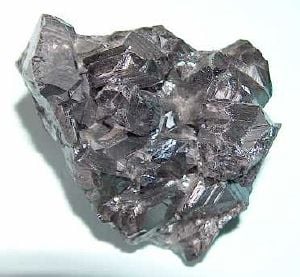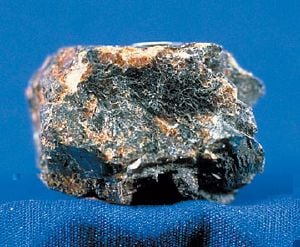Sphalerite
Sphalerite is a mineral that consists largely of zinc sulfide (ZnS) in crystalline form, but it almost always contains variable amounts of iron. It is the chief ore of zinc. When iron content is high it is an opaque black variety, marmatite ((Zn,Fe)S). It is usually found in association with galena, pyrite, and other sulfides along with calcite, dolomite, and fluorite. Miners have referred to sphalerite as zinc blende, mock lead, false galena, and black-jack.
The mineral crystallizes in the cubic crystal system. In the crystal structure, zinc and sulfur atoms are tetrahedrally coordinated. The structure is closely related to the structure of diamond. The hexagonal analog is known as the wurtzite structure. The lattice constant for zinc sulfide in the zincblende crystal structure is 0.542 nm.
Its color is usually yellow, brown, or gray to gray-black, and it may be shiny or dull. Its luster is resinous. It has a yellow or light brown streak, a hardness of 3.5 - 4, and a specific gravity of 3.9-4.1. Some specimens have a red iridescence within the gray-black crystals; these are called "ruby sphalerite." The pale yellow and red varieties have very little iron and are translucent. The darker more opaque varieties contain more iron. Some specimens are also fluorescent in ultraviolet light. The refractive index of sphalerite (as measured via sodium light, 589.3 nm) is 2.37. Sphalerite crystallizes in the isometric crystal system and possesses perfect dodecahedral cleavage. Gemmy, pale specimens from Franklin, New Jersey are highly fluorescent orange or blue under longwave ultraviolet light and are known as cleiophane, an almost pure ZnS variety.
Crystals of suitable size and transparency have been fashioned into gemstones, usually featuring the brilliant cut to best display sphalerite's high dispersion of 0.156 (B-G interval)—over three times that of diamond. Freshly cut gems are lively with an adamantine luster and could conceivably be mistaken for a fancy-colored diamond in passing, but due to sphalerite's softness and fragility the gems are best left unset as collector's or museum pieces (although some have been set into pendants). Collectors may pay a premium for stones over one carat (200 mg), as clean crystals are usually quite small. Gem-quality material is usually a yellowish to honey brown, red to orange, or green; the two most important sources are the Chivera mine, Cananea, Sonora, Mexico; and the Picos de Europa, Cordillera Cantabrica, near Santander on Spain's northern coast.
See also
ReferencesISBN links support NWE through referral fees
- Farndon, John. 2006. The Practical Encyclopedia of Rocks & Minerals: How to Find, Identify, Collect and Maintain the World's best Specimens, with over 1000 Photographs and Artworks. London: Lorenz Books. ISBN 0754815412.
- Klein, Cornelis, and Barbara Dutrow. 2007. Manual of Mineral Science. 23rd ed. New York: John Wiley. ISBN 978-0471721574.
- Pellant, Chris. 2002. Rocks and Minerals. Smithsonian Handbooks. New York: Dorling Kindersley. ISBN 0789491060.
- Shaffer, Paul R., Herbert S. Zim, and Raymond Perlman. 2001. Rocks, Gems and Minerals. Rev. ed. New York: St. Martin's Press. ISBN 1582381321.
- Mindat.org. 2007. Sphalerite. Mindat.org. Retrieved April 10, 2007.
- Mineral Gallery. 2006. The Mineral Sphalerite. Amethyst Galleries. Retrieved April 10, 2007.
External links
- Sphalerite - Minerals.net. Retrieved April 10, 2007.
- Sphalerite - The Minerals of Franklin and Sterling Hill, New Jersey. Retrieved April 10, 2007.
- The Zincblende (B3) Structure. Retrieved April 10, 2007.
Credits
New World Encyclopedia writers and editors rewrote and completed the Wikipedia article in accordance with New World Encyclopedia standards. This article abides by terms of the Creative Commons CC-by-sa 3.0 License (CC-by-sa), which may be used and disseminated with proper attribution. Credit is due under the terms of this license that can reference both the New World Encyclopedia contributors and the selfless volunteer contributors of the Wikimedia Foundation. To cite this article click here for a list of acceptable citing formats.The history of earlier contributions by wikipedians is accessible to researchers here:
The history of this article since it was imported to New World Encyclopedia:
Note: Some restrictions may apply to use of individual images which are separately licensed.


